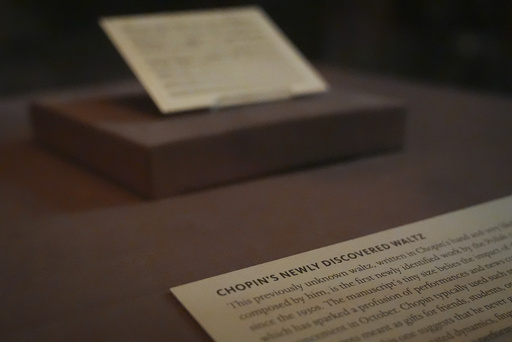
NEW YORK — A captivating waltz, composed on a small sheet of music, has emerged from obscurity, tantalizing music aficionados with its intriguing notation: “Chopin” elegantly inscribed at the top.
This piece, which remains untitled and was never signed, is currently on exhibit at the iconic Morgan Library & Museum located in Manhattan. The museum, renowned for its lavish decor, originally served as the private library of financier J. P. Morgan.
Robinson McClellan, the curator at the museum who discovered this manuscript, has stated that this marks the first significant new association with the Romantic-era composer in nearly a hundred years.
However, McClellan acknowledges that it may be impossible to determine whether this work is genuinely from Chopin himself or merely transcribed in his handwriting.
The composition in A minor features a strikingly turbulent opening, conveying a stormy atmosphere, before seamlessly transitioning into a sorrowful melody emblematic of Chopin’s signature style. “This truly reflects his essence,” McClellan remarked during a recent tour of the museum.
The manuscript was uncovered in May while McClellan was exploring a collection formerly owned by Arthur Satz, a past president of the New York School of Interior Design, who had obtained it from A. Sherrill Whiton Jr., a dedicated autograph aficionado and former director of the institution.
To validate the authenticity of the fragment, McClellan collaborated with specialists. The museum confirmed that the paper aligns with those favored by Chopin for his manuscripts, and the ink is consistent with the materials used in the early 1800s, the era when Chopin flourished. Nevertheless, a handwriting analysis revealed that the name “Chopin” was written by someone other than the composer.
Chopin, who hailed from Poland, displayed remarkable musical talent from a young age. His life journey took him through Warsaw and Vienna before settling in Paris, where he passed away in 1849 at the age of 39, likely due to tuberculosis.
His remains are interred in the distinguished Père Lachaise Cemetery in Paris, while his heart, preserved in alcohol, rests within a church in Warsaw, fulfilling his final wish to return to his homeland posthumously.
Artur Szklener, director of the Fryderyk Chopin Institute in Warsaw, has stated that the document exhibits the kind of ink and paper typical of Chopin’s early Parisian period. Szklener further emphasized that although the piece resonates with the artistry that elevated Chopin to fame, it possesses characteristics that are somewhat atypical for his compositions.
“It is not a fully developed piece but rather a musical motif containing simpler piano techniques that hint at a more virtuosic style,” Szklener elaborated in a comprehensive statement following the manuscript’s unveiling last month.
Experts speculate that this waltz could be an unfinished idea or possibly a copy of another person’s work, or perhaps even a collaborative effort, possibly intended as a learning exercise for a student.
Jeffrey Kallberg, a music professor at the University of Pennsylvania and a specialist in Chopin’s music, referred to the manuscript as a “little gem,” suggesting that it was likely intended as a gift for a friend or an affluent patron.
“Many pieces he gifted were relatively brief, akin to ‘appetizers’ leading up to more extensive works,” Kallberg noted. “It’s uncertain whether he meant for this piece to ever be publicly shared, as he frequently replicated the same waltz as gifts.”
David Ludwig, the dean of music at The Juilliard School in Manhattan, concurred that the manuscript contains many characteristics true to Chopin’s style. “It encapsulates the lyrical quality synonymous with Chopin while also exhibiting an underlying darkness,” Ludwig observed, though he did not partake in the verification process for the piece.
Ludwig added that, if authenticated, this work would be among Chopin’s briefest known compositions, with a playing time under one minute, consistent with many of the composer’s concise masterpieces.
“Regardless of its authenticity, it ignites our imaginations,” Ludwig stated. “Findings like this underscore the living nature of classical music as an ever-evolving art form.”
The revelation of this Chopin piece comes shortly after the Leipzig Municipal Libraries in Germany disclosed that they had identified a previously unknown composition attributed to a young Wolfgang Amadeus Mozart within their collection.
